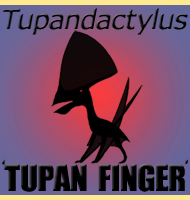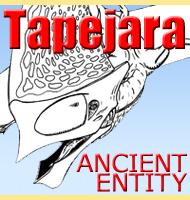


Santanadactylus
Name:
Santanadactylus
(Santana finger).
Phonetic: San-tan-a-dak-ty-lus.
Named By: Paul de Buisonj� - 1980.
Classification: Chordata, Reptilia, Pterosaur,
Pterodactyloidea.
Species: S. brasilensis (type).
Type: Carnivore/Piscivore.
Size: Estimates vary depending upon individual
specimens, and range from a 2.5 to 6 meter wingspan.
Known locations: Brazil - Cear� Formation
Time period: Aptian of the Cretaceous.
Fossil representation: Possibly 4 specimens.
No one seems to know where to place Santanadactylus within the pterosaur family tree. On top of partial remains that are different to fit into one group because of overall differences, many people also think that they belong to different genera with the other Santanadactylus species of S. araripensis, S. pricei, and S. spixi questioned over their addition to the genus. Even the holotype specimen of S. Brasilensis has been accused of being a chimera, a specimen of two or more creatures incorrectly identified as a single being. For these reasons the future validity of Santanadactylus is uncertain.
Further reading
- Santanadactylus brasilensis nov. gen., nov. sp.,
a long-necked, large
pterosaurier from the Aptian of Brasil. - Proceedings of the
Koninklijke Nederlandse Akademie van Wetenschappen, B 83:145-172. - P.
H. Buisonj� - 1980.
- Santanadactylus brasilensis: Skelet-reconstructie
van een vliegend
reptiel met zes meter vlucht. - Gea, 14(2): 37-48. - P. H. Buisonj� -
1981.
- Neue Pterosaurier aus der Santana-Formation (Apt) der Chapada do
Araripe, Brasilien. - Palaeontographica Abteilung A 187:105-182. - P.
Wellnhofer - 1985.
----------------------------------------------------------------------------
Random favourites

|
 |
 |




